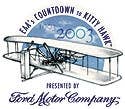
On the morning of September 13, 1900, a tall stranger came knocking at the door of William Tate's house in Kitty Hawk, North Carolina. When Tate appeared, the stranger took off his cap and introduced himself as Wilbur Wright of Dayton, Ohio, "to whom you wrote concerning this section." Staying at Tate's home until Orville arrived two weeks later, Wilbur found Tate to be as friendly and hospitable as his earlier letter indicated. Mrs. Tate, aghast that Wilbur had eaten nothing but a jar of jelly in the last 48 hours of traveling, immediately prepared him a hearty breakfast of ham and eggs. Her only worry was that their spare room might not be good enough for the well-dressed young man, but Wilbur assured her it was fine. His only request was that she boil a gallon of water each morning and place it in a pitcher in his room. Orville's near-fatal attack of typhoid fever four years before was still on his mind.
Once Orville arrived, the brothers erected, on a sandy rise between Bill Tate's house and the ocean, a tent that sudden windy squalls nearly swept away on more than one occasion. Orville did the cooking on a gasoline stove, Wilbur washed the dishes-most often with little water and lots of sand. Their diet was limited-bacon, canned vegetables, rice, tomatoes, eggs, cornbread or biscuits and an occasional chicken.
|| |---| | | | The Wright brothers' 1900 glider was flown as a kite.| The glider was completed the first week in October. During the next few days, the Wrights, aided by Bill Tate, tested the glider heavily, until a sudden gust of wind flung it off into the sand, mangling the wings badly … so much so that the brothers seriously considered returning to Dayton. For while they had flown the machine as a weighted kite from two to four hours, they had managed just 10 minutes of glide time with a man on board. Outside of learning it was not feasible to work the front rudder and the wing-warping mechanism at the same time, they had accomplished little. Undaunted, they dragged the damaged glider back to camp for repairs, but their next foray-during which they flew it as a kite with a variety of loads-was disappointing. Said Orville: "Will was so mixed up, he couldn't even theorize. It has been with considerable effort that I have succeeded in keeping him in the flying business at all."
On October 20th, however, things turned around. That day, the Wrights made a dozen successful glides, some as long as 20 seconds for a distance of nearly 400 feet, although they found the problem of lateral equilibrium still troublesome. In spite of that, they had good reason to be pleased. Rather than merely dangling from a glider like Lilienthal, they had used their hands and brains to maintain equilibrium for a respectable distance … and survived.
Wrote Wilbur, "We considered it quite a point to … return without having our pet theories completely knocked in the head by the hard logic of experience, and our own brains dashed out in the bargain."
This "Kitty Hawk Moment" is brought to you by the EAA, whose Countdown to Kitty Hawk program, presented by Ford Motor Company, includes an exact flying reproduction of the Wright Flyer. It is the centerpiece of the EAA's national tour during 2003, which will conclude with a five-day celebration at Kitty Hawk, North Carolina, where the Wright Flyer will fly again at exactly 10:35 a.m. on December 17, 2003, commemorating 100 years of powered flight.

Sign-up for newsletters & special offers!
Get the latest FLYING stories & special offers delivered directly to your inbox






